Jax Tides and Their Effects on Kiteboarding Performance
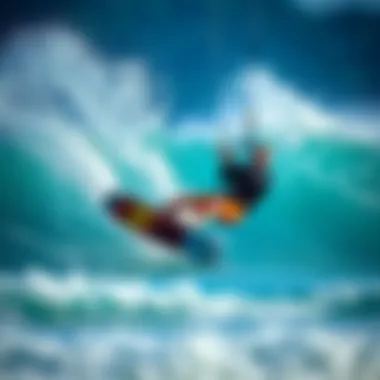
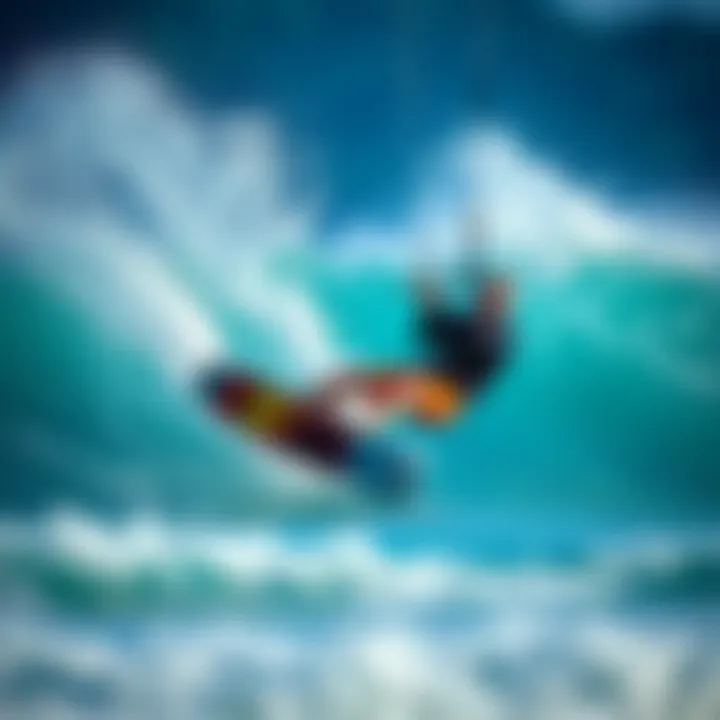
Intro
Understanding how tides work in Jax is crucial for kiteboarders looking to optimize their riding sessions. The interplay between the moon’s gravitational pull, the local topography, and prevailing winds shapes the tides that kiteboarders encounter. Knowing how these factors affect water conditions can be the difference between a thrilling ride and a challenging session.
Why Tides Matter
Tides influence not just the depth and flow of water but also the water surface and wind conditions. An experienced kiteboarder knows that high tide and low tide can drastically change the nature of the waves and currents. Failing to take these changes into account can lead to accidents or just disappointing rides. Understanding Jax tides is like knowing the lay of the land before setting out on a trek; it can keep you safe and enhance your enjoyment.
As we dive deeper into the specific impact of Jax tides on kiteboarding performance, we’ll cover essential gear and techniques that cater to both beginners and seasoned riders.
Gear and Equipment
When kiteboarding in Jax, having the right equipment is pivotal. Not only does it enhance performance, but it also ensures safety while navigating the often unpredictable waters.
Essential Kiteboarding Gear for Beginners
- Kite: A beginner should opt for a stable and beginner-friendly kite, like the Slingshot Ignition, known for its easy handling.
- Board: A larger board brings more stability, making it easier for new riders to get their balance. The Naish Slice is a well-regarded option.
- Harness: A comfortable harness is key. Look for something that offers good support without restricting movement, like the Mystic Warrior.
- Safety Gear: At the very least, invest in a helmet and a flotation vest. They provide vital protection in case you take a spill.
Advanced Equipment for Experienced Riders
For those seasoned in kiteboarding, the equipment can be tailored for performance rather than just safety.
- High-Performance Kites: Consider switching to a more dynamic kite such as the North Rebel for advanced tricks.
- Sized Boards: Pro riders may opt for smaller, lighter boards like the Liquid Force Space Pickle for increased maneuverability.
- Foil Boards: A foil board can let experienced riders glide above the waves, creating a unique experience especially during certain tidal conditions.
"The right equipment not only changes your game; it opens new doors to what kiteboarding can be."
Choosing gear suited to your skill level and the tidal conditions in Jax can significantly enhance your performance on the water. It’s not just about having the latest model, but rather selecting equipment that matches your capabilities and the specific dynamics of the local tides.
Understanding Tides
Grasping the concept of tides is crucial for anyone keen on kiteboarding, especially in regions like Jacksonville, where water dynamics can shape the riding experience. Knowing how tides function allows kiteboarders to maximize their sessions and enhance safety. As tides can dictate wave conditions, wind patterns, and navigation routes, understanding this aspect is key for both novices and seasoned kiteboarders. Effective timing relative to the tides increases enjoyment and reduces risks.
The Science Behind Tides
Tides are primarily influenced by the gravitational pull of the moon and the sun. The scientific principle underlying this phenomenon is known as tidal force. Waters on the Earth's surface are pulled toward these celestial bodies, leading to the creation of high and low tides. The angle of the Earth’s tilt and its rotation also play essential roles in determining when and how these tides occur.
Waves aren’t just random occurrences; they follow a rhythmic pattern dictated by these gravitational forces. Furthermore, factors such as local wind conditions, atmospheric pressure, and the geographical layout of the coastline can modify how these tides behave in any given area. Understanding these scientific concepts provides the backdrop for effectively planning a kiteboarding session.
Types of Tides
In tides: High and Low
Among the most fundamental types of tides are the high and low tides, generated by the constant dance between the Earth, the moon, and the sun. High tides occur when the water level rises significantly, usually twice a day, while low tides are marked by a noticeable drop in sea levels. This alternating cycle typically provides kiteboarders with critical insights regarding the best times to ride.
The key characteristic of high tides is that they create expansive, deep water conditions that are often safer for thrilling maneuvers. This essentially opens up more riding time to kiteboarders who prefer surf-driven speeds. Conversely, during low tides, water recedes to expose sandbars and shallow areas which can be both advantageous and a bit challenging. Although low tides can be a nightmare for navigation, they also present opportunities for advanced riders to master their skills in trickier conditions.
Spring and Neap Tides
Spring and neap tides add another layer of complexity to the kiteboarding scene. Spring tides, which occur roughly twice a month, generate the highest high tides and lowest low tides whenever the Earth, moon, and sun align. This phenomenon results in powerful currents and excellent riding conditions, favored by kiteboarders who seek an adrenaline rush.
In contrast, neap tides occur when the sun and moon are at right angles relative to each other, leading to a reduced tidal range. While conditions may be less dramatic during these periods, an understanding of spring and neap tides helps kiteboarders plan their outings effectively based on preferences for intensity or levels of challenge. Kiteboarding during these varying conditions tests the skills of riders, showcasing how adaptability is key.
In summary, understanding the nuances of high and low tides, along with spring and neap tides, is instrumental in planning productive kiteboarding sessions in Jacksonville. Knowing these tides will help maximize safety and enjoyment on the water.
Geographical Influence on Tidal Patterns
Understanding the geographical factors that influence tidal patterns in Jacksonville is crucial for kiteboarders looking to get the most out of their sessions. The way land meets water affects not just the height of the tide but also its consistency and behavior. For kiteboarding, this insight translates into better safety, strategic planning, and overall performance. Factors such as tidal range variability and the impact of land forms come into play, shaping both the kiteboarding experience and safety protocols.
Tidal Range Variability
Local Geography
The local geography of Jacksonville has a profound effect on how tides behave. The St. Johns River, for example, creates distinct tidal patterns that are markedly different from more uniform coastlines. The river’s shape creates areas of concentrated tidal flow, causing certain spots to experience stronger currents. This variability is key for kiteboarders, as it allows riders to select locations that complement their skill levels and preferred riding conditions.
One of the main characteristics of Jacksonville’s local geography is its intricate shoreline. This complexity typically results in varying tidal ranges, where some areas may experience high tides earlier than others. For kiteboarders, this means they can plan their sessions with precision, knowing when and where to catch the best conditions. However, it can also create tricky spots for navigation, as tides might recede faster in certain inlets.

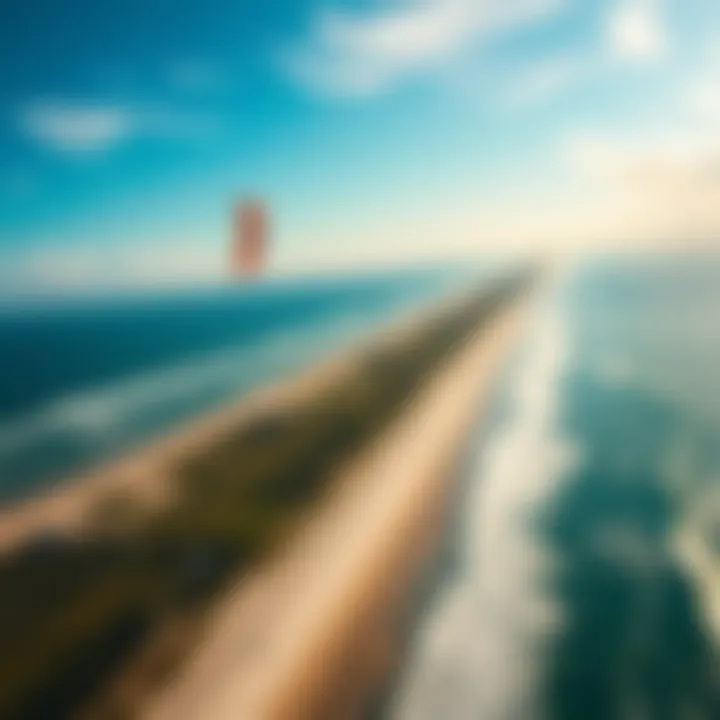
Coastal Topography
Another significant element in Jacksonville’s tidal influence is its coastal topography. The mixture of sandy beaches and rocky outcrops creates a landscape where wave action and incoming tides interact uniquely. For kiteboarding, coastal topography adds a layer of complexity. Wave breaks may become more pronounced at certain tides, impacting both riding style and technique.
The steep rise of coastal topography can create localized wind conditions that kiteboarders might exploit for higher jumps or tricks. However, navigating these areas also comes with risks, as unexpected waves could challenge even experienced riders. Knowing the topography means being ready for both the opportunities it offers and the hazards it presents.
Impact of Land Forms
Estuaries and Inlets
Estuaries and inlets around Jacksonville serve as critical connectors between rivers and the ocean, affecting tidal behavior significantly. These areas often experience unique tidal rhythms, where the mixing of freshwater and saltwater creates diverse aquatic conditions. For kiteboarders, this means access to different water textures, wind conditions, and currents.
A notable feature of these estuaries is their ability to trap water, causing local tidal ranges to differ from coastal zones. This characteristic often advantages beginners, who find the calmer conditions promote a more manageable experience for learning. However, the dynamic nature of inlets also means kitesurfers should remain vigilant, as currents can shift unexpectedly.
Sandbars and Shallows
Sandbars and shallows play a pivotal role in determining where kiteboarders will thrive or struggle. These formations provide flat, shallow waters that are ideal for many kiteboarding tricks and maneuvers. However, they can also present challenges when the tides recede, as they expose hidden obstacles and drastically change water levels.
The primary characteristic of sandbars is their shifting nature; they can vary greatly depending on the tide. This variability can create exciting riding conditions at high tide, while low tide may force adjustments in strategy. Mastering the interaction between sandbars and tidal shifts can elevate a kiteboarder’s performance, but caution is advised to avoid potential hazards.
Riding during the right tidal conditions can turn an average kiteboarding session into an exhilarating adventure. Always check local tidal forecasts before hitting the water.
Jax Tides: Characteristics
Understanding the characteristics of Jax tides is fundamental for kiteboarders looking to enhance their performance and safety on the water. The interaction between tidal patterns and kiteboarding can significantly alter the riding experience, affecting everything from wind conditions to water depth. Knowledge of local tide characteristics aids riders in planning their sessions more effectively, ensuring they make the most of their time on the water.
Unique Features of Jax Tides
Time Patterns
Time patterns in Jax tides are not just about observing the clock; they play a crucial role in determining optimal kiteboarding conditions. These time patterns dictate when high and low tides occur, impacting how water flows and creates waves. The distinct characteristic of Jax's tidal time patterns is their regularity, usually following a semi-diurnal wave pattern, meaning there are two high tides and two low tides each day.
This regularity is beneficial as it allows kiteboarders to plan their sessions ahead of time, making the most of favorable conditions. However, one disadvantage might be that, during certain periods, low tides can expose large sandbars or other underwater structures, leading to potential hazards. Therefore, understanding these patterns is essential.
Seasonal Variations
Seasonal variations in Jax tides bring about shifts that can be quite impacting on kiteboarding activities. The most prominent characteristic here is how tidal ranges can fluctuate between winter and summer months; during summer, can lead to higher tides due to moon alignments.
Such variations provide kiteboarders with different water levels and conditions throughout the year, allowing for a diverse riding experience. Yet, there's a downside; as the seasons change, so do the weather patterns, which can sometimes lead to unpredictability in wind strength and direction. A rider needs to know the specific seasonal influences to adapt their strategies accordingly.
Predictability of Tides
The predictability of tides helps kiteboarders better prepare for their sessions. Unlike a wild goose chase, understanding tidal behavior can make or break a day on the water.
Understanding Tidal Charts
Tidal charts are like maps for understanding the ebb and flow of Jax tides. They provide vital information about the expected height and timing of tides. A key characteristic of these charts is that they visually represent tidal changes over time, allowing kiteboarders to anticipate conditions. This foresight is immensely beneficial, reducing the risk of being caught out in unfavorable circumstances. Yet, while these charts are generally accurate, unexpected weather changes can still disrupt predictions, making it essential to keep an eye on real-time updates.
Apps for Real-Time Data
Embracing technology, various apps provide real-time data on tides, wind, and weather conditions related to kiteboarding. These apps are indispensable for those wanting to keep their finger on the pulse of changing conditions. They offer features that highlight the best times to hit the water based on current tidal fluctuations. However, while these digital tools are beneficial, reliance on them can sometimes lead to complacency; it’s still important for kiteboarders to combine digital information with their observations.
Effects of Tides on Kiteboarding
The influence of tides on kiteboarding performance cannot be understated. Understanding how tides interact with wind patterns and water conditions can be the difference between a mediocre session and an exhilarating ride. Kiteboarders, whether novice or experienced, benefit immensely from grasping the intricate dance between tidal movements and their impact on water sports.
Tides significantly affect the characteristics of the water's surface, which in turn shapes the dynamics of kiteboarding. Factors like wind strength, water level changes, and even the presence of obstacles or hazards are closely tied to tidal conditions. Maximizing the quality of their kiteboarding experience hinges on recognizing the nuances of these shifting tides.
Maximizing Session Timing
Optimal Conditions for Beginners
For those just beginning their kiteboarding journey, the early morning or late afternoon sessions during high tide often present the ideal conditions. The water is usually smoother at these times, reducing the chance of encountering waves that might intimidate new riders. Moreover, the increased water level offers more room for errors, which is particularly beneficial for those still mastering basic skills.


"Timing your session according to the tides can help beginners feel more confident and safe as they learn to maneuver on the water."
The gentler conditions of a high tide provide less resistance, allowing beginners to practice their balancing skills without the overwhelming challenge of chop or strong currents. However, one should remain mindful that shifting conditions can occur, and hence staying informed through updated tidal charts is crucial.
Advanced Riding Strategies
For seasoned kiteboarders, tides can serve as a canvas to strategize advanced riding techniques. When the tide is low, for instance, riders might explore using flat water areas, providing unique opportunities to work on tricks with minimal interference from waves. This setting is often appealing to those wanting to perfect their jumps or maneuvers.
The changing water depth can also present challenges; as the tide goes out, sandbars may emerge or ground-level debris become more prevalent. A savvy rider learns to adapt by adjusting their speed and approach, and indeed, this adaptability can often lead to a more rewarding experience. Understanding these factors allows experienced kiteboarders to take full advantage of the tides, turning potential disadvantages into opportunities for skill enhancement.
Safety Considerations
Understanding Rip Currents
Recognizing rip currents is crucial for any kiteboarder looking to stay safe on the water. These powerful waterways form in areas where tides flow over sandbars or other underwater features, creating strong currents that can pull even the most experienced riders away from shore. Awareness of rip currents can help kiteboarders avoid potentially dangerous situations, ensuring a safer outing.
The primary characteristic of rip currents is their unpredictable nature. They can vary in strength and location, making it essential for riders to assess conditions thoroughly before heading out. Predictability is not a friend to rip currents; thus, familiarity with local geography and water patterns enhances awareness and safety.
Navigation During Low Tide
Navigating during low tide introduces its own set of challenges and opportunities. With potentially visible sandbars, rocks, and other obstacles, kiteboarders must carefully plan their routes before launching. Low tide can also alter wind patterns, creating tricky conditions that require a keen eye for detail and adaptability.
Understanding how to navigate in low tide situations becomes essential, especially in locations like Jax where the tides fluctuate considerably. Knowledge about the depth of water, local hazards, and changing wind patterns during low tide can ensure that sessions remain enjoyable rather than hazardous. For kiteboarders who hone their navigational skills during these lower water levels, remarkable experiences and improved flexibility in riding can emerge.
In summary, the effects of tides on kiteboarding encompass more than just water depth and wave size. They shape every aspect of the kitesurfing experience from timing sessions to enhancing safety measures. Adapting one’s approach depending on tidal conditions not only maximizes performance but enriches the entire kiteboarding adventure.
Gear Selection Based on Tidal Conditions
Choosing the right gear based on the tidal conditions is pivotal for kiteboarders. Understanding how factors such as wind strength and water levels impact equipment performance is crucial. This ensures that each session is not only enjoyable but also safe. The relationship between tides and gear capabilities can make the difference between a thrilling ride and a disappointing day on the water.
Kite Choice for Tidal Variability
Adjusting for Wind and Water Levels
When we talk about adjusting for wind and water levels, it’s about selecting a kite that matches the conditions. For instance, in lower water levels, a larger kite might catch enough wind to lift you, especially on those flat days when the water feels like a glassy mirror. The ability to fly comfortably in varying conditions is a key trait for any kite.
A popular choice among kiteboarders navigating Jax tides is the all-rounder kite, known for its versatility. Whether you face gusts from sudden winds or smooth sailing with minimal turbulence, this kite can handle it well. Its unique design typically includes a larger surface area, which helps harness more wind, allowing for better lift, particularly in patchy wind conditions.
However, it’s worth noting that while larger kites catch more wind, they also can be cumbersome in strong winds. Thus, understanding the local wind patterns becomes imperative. Riders need to gauge their environment, looking for signs like how the trees move or cloud formation.
Recommended Equipment for Jax
In Jax, the recommendation leans toward kites such as the North Rebel or Slingshot RPM when it comes to navigating the tides. These models have stood the test of time and had rave reviews among local kiteboarding enthusiasts.
The North Rebel, for instance, is especially popular due to its excellent stability in varying wind conditions. This model has been crafted to provide a responsive feel, critical for kiteboarding maneuvers. Another considerable advantage is its robust construction, giving riders the confidence to tackle both aggressive tides and calm waters alike.
Still, like any gear, these models aren't without their downsides. They may not be as agile in tight spaces, which can be a disadvantage in crowded areas. Therefore, potential riders should weigh these factors based on their skill level and the conditions they anticipate.
Board Adaptation Strategies
Selecting the right board is equally pivotal. It's about ensuring your board complements the kite's performance and the tidal conditions you will encounter.
Sizing for Conditions
When it comes to sizing, the lighter the winds, the larger the board should generally be. A bigger board can carry more weight and maintain momentum in slack currents, while a smaller board works well when the winds are robust. This is a crucial aspect in real-life scenarios where the tide can dictate whether you glide smoothly or struggle to stay afloat.
For example, in lighter tidal conditions often found in Jax, riders frequently opt for wider boards, which provide better buoyancy. This is especially beneficial for those new to the sport.
But larger boards can be a double-edged sword. While they offer stability, they can feel sluggish in faster waters. Thus, knowing when to switch should be on every rider’s radar.
Design Feature Considerations
The design of a board should also align with on-the-water conditions. Twin-tip boards, for instance, offer great versatility, making them a common choice for many. They can be ridden in both directions, which is especially handy when the tide shifts unexpectedly. This adaptability is a significant benefit for experienced riders who want to explore during their sessions.
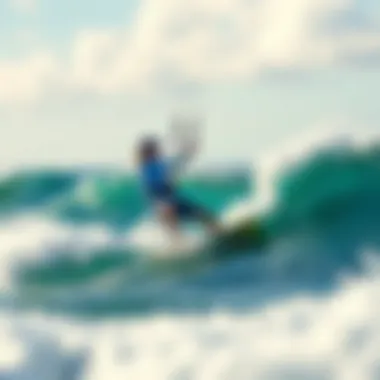
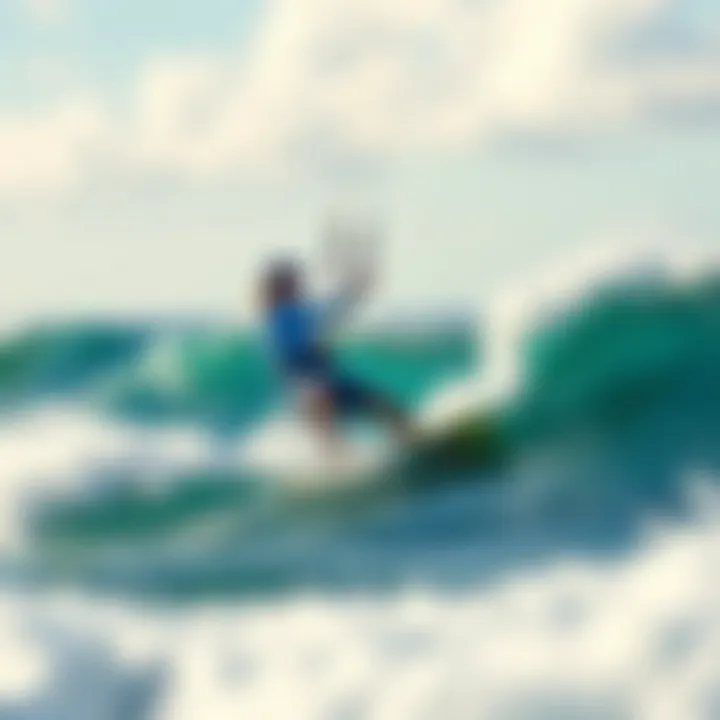
However, a narrower board design can provide the nimbleness required for sharp turns and tricks. The tradeoff here lies in its performance in choppier waters.
Case Studies: Jax Tides in Action
The exploration of real-life examples surrounding Jax tides offers invaluable insights into kiteboarding performance. Case studies provide a practical lens through which both novice and experienced kiteboarders can grasp the nuanced dynamics of how tides can influence their sessions. These accounts can shed light on various conditions that riders encounter, making this section essential for understanding the broader implications of tidal patterns.
Real-Life Kiteboarding Experiences
Interviews with Local Riders
Insider perspectives from local kiteboarders reveal a wealth of knowledge that is usually missed by beginners. During interviews, seasoned riders often emphasize the importance of tide timing. They explain how shifting tides can affect not just safety, but also the thrill of the ride. Such discussions highlight their personal stories, covering everything from memorable kiteboarding experiences on high tides to the unexpected challenges faced during low tide.
One of the biggest benefits of these interviews is the intimate knowledge shared about local conditions. Riders might speak about favorite spots that are more effective during specific tidal phases. The dynamic conditions can change swiftly; therefore, understanding the tide's moods can lead to better sessions overall.
In addition, these interviews showcase the personal struggles and triumphs they’ve experienced. It’s one thing to read about tides but entirely another to hear how those tides impacted their day on the water.
Comparative Analysis of Different Days
A comparative analysis provides a unique aspect by looking closely at multiple days under variable tidal situations. The difference in kiteboarding experiences on a day with a strong incoming tide versus a calm outgoing tide can be staggering. Such analysis helps understand consistency—or the lack thereof—within conditions.
This comparison reveals crucial insights into rider adaptability. For instance, a day with high waves during a spring tide could be exhilarating but also dangerous for inexperienced riders. This underscores the necessity for adjusting one's skills and equipment based on tidal conditions.
Moreover, comparing performance on different days lays the groundwork for informed decision-making. Identifying patterns of what worked or flopped serves as a reference point for what a kiteboarder might expect any given day. This feature is beneficial as it imparts tangible knowledge backed by practical experience, enriching the overall discussion surrounding performance.
Expert Insights
Tips from Professional Kiteboarders
When it comes to elite insights, professional kiteboarders provide practical tips that can substantially enhance your experience. They often share wisdom that comes not just from skill but also from navigating the complexities of water and wind patterns. Their expertise can contribute holistically to understanding how Jax tides affect performance.
The standout quality of such tips is that they aren’t mere abstract notions, but rather actions that riders can implement immediately. For instance, many advise evaluating currents daily and adjusting accordingly. This kind of practical advice has the potential to elevate one’s kiteboarding skills substantially.
Also, professionals may touch upon gear choices in alignment with tidal changes, giving readers a firsthand look at the intricacies involved.
Analysis from Local Coaches
Local coaches often take a methodical approach in their analysis of tides and kiteboarding. They analyze from a pedagogical perspective, offering invaluable insights that help improve performance. Coaches usually focus on what new riders should practice on particular days with varying conditions.
The unique aspect of local coaching is the focus on learner adaptability. Coaches can closely observe how students respond to tidal changes, allowing them to tailor their instructions accordingly. This insight becomes a key asset for anyone looking to refine their skills more effectively.
The practical teaching of practical tidal patterns can also serve as a foundational lesson for future riding sessions. With such analysis, both new and seasoned kiteboarders can approach their sessions with greater confidence, knowing they are practicing under the right conditions.
"Tides are unforgiving. Nature does not wait for you to learn; it molds your experience, success, and sometimes your failures."
— Local Kiteboarder
By exploring these case studies, we see that the relationship between Jax tides and kiteboarding performance is multifaceted. The experiences, tips, and analyses presented serve as essential resources for anyone eager to deepen their understanding and optimize their sessions effectively.
The End: Mastering Jax Tides
Understanding Jax tides is crucial for kiteboarders who want to enhance their performance and overall experience on the water. This section emphasizes that mastery of tidal knowledge translates into safer, more enjoyable sessions, especially in a place where tidal conditions can shift dramatically.
As laid out throughout the article, three core elements surface as particularly significant:
- Timing Your Sessions: The right tidal state—whether it’s nearing low tide or just before high tide—can make all the difference in your ability to ride effectively. Boarders who plan their outings with tidal patterns in mind are bound to have more successful sessions.
- Gear Adaptation: Knowing the type of conditions presented by different tidal scenarios will inform equipment choices. Riders not only need to consider their kite size and board design but also their personal skill level relative to those conditions.
- Safety Precautions: Tides can introduce challenges such as rip currents and shifting winds. Developing an understanding of these hazards will equip riders to navigate the waters with more assurance and reduce risks.
In summary, being well-versed in Jax tides fosters an environment where kiteboarders can thrive. The connection between tidal knowledge and performance isn’t just theoretical. It is practical, actionable, and vital for anyone looking to get the most from their kiteboarding pursuits.
Key Takeaways
- Knowledge of tide dynamics leads to safer and more enjoyable sessions.
- Equipment selection should be tailored to current conditions and personal experience levels.
- Always remain aware of local hazards associated with changing tides.
Utilize the tools at your disposal, whether they be reliable tidal charts or recommended apps, to enhance your water experience.
Future of Kiteboarding in Tidal Contexts
As kiteboarding grows in popularity, adapting to tidal influences will become even more integral to the community. Innovations in gear and advancements in technology will likely play pivotal roles. For instance, gear manufacturers are increasingly integrating data from tidal patterns to develop more adaptive kite designs.
In future contexts, you might see:
- Smart technology in kites that adjusts sail area automatically based on water conditions.
- Expansion of educational programs focusing specifically on tidal navigation for beginners and experienced riders alike.
- Improved community resources, like localized forums or apps for real-time conditions, which will enhance riders' understanding of how tides affect their favorite spots like Jacksonville.
In a nutshell, embracing the ever-changing characteristics of tides opens doors to advanced riding, community collaboration, and proficiency. As kiteboarding enthusiasts tune into these factors, they will individually and collectively redefine the sport, ensuring it continues to grow sustainably amid varying tidal contexts.



